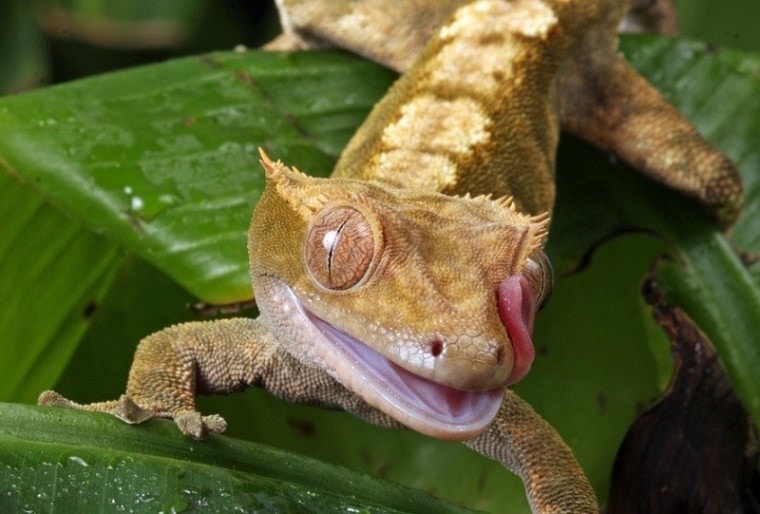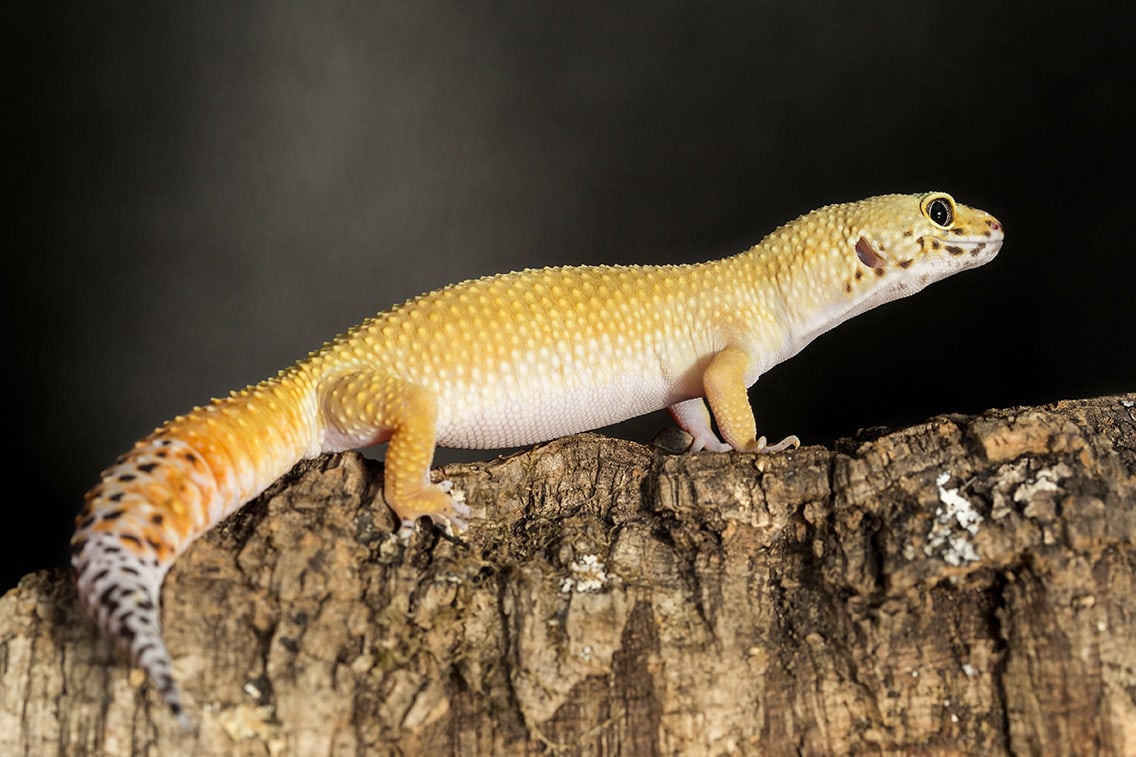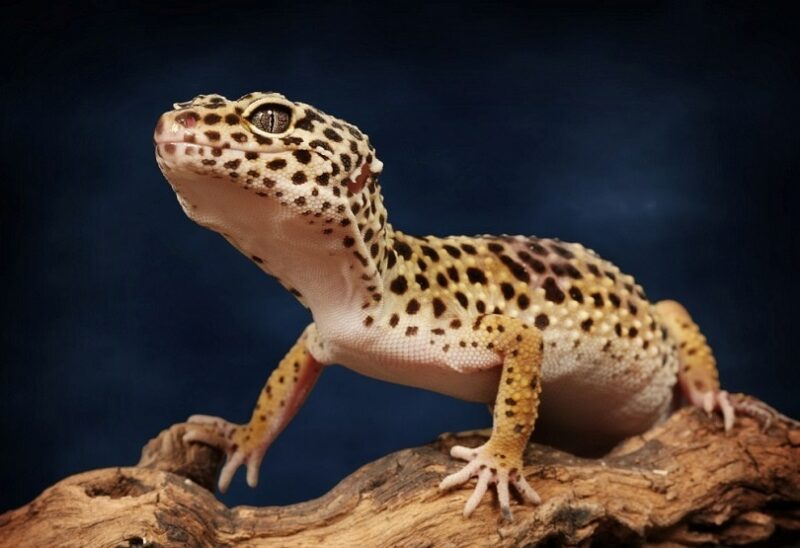
If you want a fun, non-traditional pet that’s easy to care for, the crested gecko is an excellent choice. These dashing little lizards come in a variety of striking colors, live long lives, and are incredibly interesting to watch.
Of course, given that many people have never owned pets besides cats and dogs, you may not know the proper protocol for caring for a crested gecko. Below, we’ll provide you with everything you need to know about to keep one of these beautiful reptiles happy and healthy.
Quick Facts About the Crested Gecko
| Species Name: | Rhacodactylus ciliatus |
| Family: | Diplodactylidae |
| Care Level: | Low |
| Temperature: | 65°-80°F |
| Temperament: | Calm, docile |
| Color Form: | Cream, yellow, olive, red, black |
| Lifespan: | 15-20 years |
| Size: | 5-8 inches |
| Diet: | Crickets, mealworms, fruit |
| Minimum Tank Size: | 20 gallons |
| Tank Set-Up: | Glass terrarium with screen for ventilation; plenty of objects to climb on |
| Compatibility: | Low |
Crested Gecko Overview
Today, crested geckos are one of the most popular pets for reptile lovers to own. It wasn’t always that way, however — they were actually believed to be extinct until 1994!
Fortunately, these animals are easy to breed, so while their numbers were low at one time, they quickly came roaring back. These lizards are big business nowadays, as countless owners have fallen in love with how resilient and low-maintenance they can be.
This makes them excellent options for children who want their own pet but aren’t ready for the demands of caring for a dog or cat. Even better, if the child becomes bored and the job of caring for the lizard falls to you, crested geckos won’t take up a bunch of your time and money.
They’re also a good fit for novice reptile owners who are dipping their toes into the hobby. They may not be the most exotic reptile that you can buy, but they’re not finicky, and you won’t have to worry about constantly fiddling with their habitat or trying to encourage them to eat.
In nature, crested geckos are found exclusively in the rainforests of New Caledonia, an island off the coast of Australia. However, almost all crested geckos that are sold today have been bred in captivity, as the capture of wild crested geckos has been banned by the New Caledonian government.

How Much Do Crested Geckos Cost?
You can likely find a crested gecko for somewhere between $50 and $100. The price will vary depending on a host of factors, including the gecko’s age, gender, and morph (“morph” includes their pattern, size, and coloring).
Some crested geckos with especially rare or exotic morphs can go for $500 or more, but these are limited to hardcore enthusiasts. If you’re just starting out, you shouldn’t need to pay more than $100.
Typical Behavior & Temperament
Most crested geckos are fairly laidback and docile, but they can be skittish if they feel threatened. This means they usually don’t enjoy being handled, but they can come to tolerate it if you do so responsibly. They tend to run when scared, but they may also jump away, drop their tails, or bite. Their bites are usually not serious and seldom break the skin, but they can certainly startle you.
The biggest concern when handling them is that they’ll escape, so don’t take any chances.
Appearance & Varieties
Color
Crested geckos are extremely varied in terms of appearance. They can come in just about any color of the rainbow, although they’re most commonly brown or cream. They’re seldom one solid color, though, and they’re usually patterned with dark spots or lateral stripes. Their coloration isn’t genetically fixed, so you can’t guess what a baby crested gecko will look like by eyeballing their parents.

Physical Features
While their coloration can vary wildly, all crested geckos have a pronounced crest that begins on top of their head and moves down their back. However, the size and length of the crest can vary from individual to individual. The crest looks spiky, giving the lizard a somewhat fierce appearance. It’s not painful to handle, however, but you should still leave it alone as much as possible.
Their feet have rounded toe pads that make it easier for them to grab onto vertical surfaces. They’re talented climbers, but far from the best in the lizard world. Still, you should give them plenty of places to climb and explore inside their terrarium. They have big eyes and no eyelids; instead, a narrow slit covers their eyeball. Like many lizards, they’ll lick their own eyes to moisten them and remove debris.
Crested geckos are incredible leapers, so you’ll want to give them plenty of space to jump around. They especially love to jump from branch to branch, and their prehensile tails help them attain lift-off with ease.
Gender
Most juvenile geckos are sold “unsexed,” so you won’t know what gender your new pet is until they fully mature. However, you can also buy identifiable juvenile males and females, although these will usually be more expensive. Females are usually more expensive in general, but that’s because they’re better suited for group living than males. You can keep three or four female crested geckos in one enclosure, but it’s rare to find many males that will tolerate living in close quarters with one another.
How to Take Care of Crested Geckos
One of the biggest selling points of crested geckos is a low-maintenance lifestyle. Even so, there are a few things that you need to be aware of before adding one to your menagerie.
Habitat, Tank Conditions & Setup

Are Crested Geckos Good Tank Mates?
There’s a certain amount of disagreement as to whether crested geckos desire companionship inside their tanks. It’s generally agreed that they don’t need another animal to share their habitat with, but some geckos — particularly females — seem to tolerate having friends around.
However, be careful about what kinds of animals you pair with your crested. Two males should never be put together, as they’ll fight over resources and territory, but as many as three or four females can live in harmony.
It’s generally not advisable to put other reptiles in the tank with them. If you introduce any different species, make sure it’s not something that will see your crested as prey (such as toads or certain insects). You may be able to include certain types of harmless insects, like millipedes, but there’s always the chance that the gecko will then see them as a snack.
It’s important to understand that crested geckos don’t need other animals around for emotional support; however, they may enjoy having them for stimulation. If you want to enrich your gecko’s tank, the best way to do it may be to put another animal (such as fish) in a separate tank next to the gecko’s habitat.
What to Feed Your Crested Gecko
Like most lizards, crested geckos rely heavily on insects to make up their diet. You’ll want to have a fresh supply of crickets, mealworms, and waxworms available for them at all times, and you can feed them daily. You can also give your gecko small bits of fruit like banana, peach, and mango, or many pet stores sell food specifically made for crested geckos.
Just because your crested eats insects, that doesn’t mean they’ll eat any insect you throw in the tank. Resist the urge to feed them anything that you can catch, because many insects can harm your gecko. This is especially true if they’re left in the tank with them too long.
Make sure you don’t feed them anything venomous, like spiders, and avoid large insects that may injure them in a fight. It’s best to just stick to insects that you can buy at a pet store.
Since crested geckos are nocturnal, you should only feed them once every night. Then, when you wake up in the morning, you can remove any food that they didn’t scarf down.

Keeping Your Crested Gecko Healthy
Crested geckos are hardy animals, so it’s relatively easy to keep them healthy. There are still a few things that you should know to preserve their well-being, however.
The easiest way to ensure that you have a healthy crested gecko is to start with a healthy crested gecko. Just because someone is selling crested geckos, that doesn’t mean they know how to take care of them, and you may get sold a sick or weak gecko simply out of ignorance (and occasionally malice).
When shopping for a crested gecko, make sure it’s alert, curious, and stable. Make sure there isn’t any discharge around their eyes, nose, or vent, and check that their hip bones and ribs don’t protrude. These are all signs of illness in a gecko that you’ve owned for a while too, so don’t just check for these things before making a purchase.
The two most important factors in keeping your crested gecko healthy are food and stress. Make sure they have plenty of food to eat, but don’t allow them to become overweight.
As for stress, many factors can play into it. Dehydration puts a great deal of stress on them, so make sure they have access to clean water and mist their enclosure with a spray bottle every night. Minimize your intrusion into their world, which means not picking them up or interacting with them unless necessary.
Also, make sure the tank is properly ventilated. If all you do is provide moisture with no ventilation, then mold can form, leading to respiratory problems for your lizard. You should also pick up their waste every day so bacterial growth doesn’t get out of hand and possibly sicken them.
Breeding
As you might expect, given the fact that the species went from nearly extinct to readily available in the span of a few decades, crested geckos are easy animals to breed. Even complete novices can successfully create baby crested geckos on their first try.
It’s important to wait until both animals are sexually mature, though. For females, this means they’re at least 1 ½ years old and weigh at least an ounce. Males need to be a little older (around 2 years or so), but they can weigh a bit less.
The actual breeding process will vary depending on the male involved. Some males are quite gentle, merely courting the female with head bobs and chirps. However, others can be quite aggressive, biting the female by the crest and pinning her down to mount her. Both are normal behaviors and no cause for concern; in either case, the two animals will stay locked together for several minutes while copulation occurs.
You can keep a breeding pair together year-round, but it’s not necessary for breeding purposes. Females retain sperm for several months, so a few breeding sessions a year is all that’s necessary to ensure successful reproduction.
Females will lay a clutch of eggs every 30 to 45 days during their breeding season. When she’s ready to lay her eggs, the female will find a moist spot to do so. Providing her with a special egg-laying box will make her more comfortable while also making it easier for you to find the eggs once she’s finished.
Are Crested Geckos Suitable for Your Aquarium?
If you already have an aquarium and are considering adding crested geckos to it, make sure that the tank is large enough and that there are no other animals inside that will pose a threat to your lizards.
You may need to buy a few supplies that you don’t already have on hand, such as a UVB bulb or a thermostat, to make your aquarium suitable for your new pet. For the most part, though, crested geckos don’t require much in the way of special gear.
But generally speaking, it’s best to buy new stuff for your new lizard. Most fish aquariums aren’t ideal for crested geckos, as they need at least one side to be made of mesh to provide ventilation, although you may be able to get away with just providing a mesh lid.
If you’re looking for a low-maintenance pet that’s still capable of providing tons of entertainment, then crested geckos are a wonderful option. These little lizards are always doing something interesting, and they need little in the way of care or supervision.
They make great pets for children and reptile lovers, but be aware that they live for as long as 20 years, so they’re not a commitment to be taken lightly. Then again, they’re so much fun that 20 years doesn’t really seem like enough time to spend with them!
- You may also be interested in: Halloween Crested Gecko: Info & Care Guide for Beginners (With Pictures)
Featured Image Credit: No-longer-here, Pixabay








